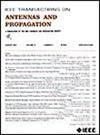基于偏振解耦方法的宽带双极化高选择性角选择表面
IF 5.8
1区 计算机科学
Q1 ENGINEERING, ELECTRICAL & ELECTRONIC
引用次数: 0
摘要
这项工作提出了一种设计宽带,高选择性,双极化角选择表面(ASSs)的新方法。提出了一种利用平行板波导中截止频率的角色散特性设计宽带tm极化自动导航系统的方法。此外,在相邻的金属板之间加入了额外的短路带,以产生与角度相关的传输零点(TZs),从而增强了角度选择性。随后,为了实现双极化,提出了一种极化解耦方法,该方法将仅对TE极化有效的as集成到基于tm有效的ppw结构中。te有效的ASS作为二阶空间滤波器,利用介质传输线(DTLs)的色散来控制其角响应。最后,将TE有效和tm有效的ASS协同设计,得到一个双极化ASS。所提出的ASS在6.5 ~ 9ghz的宽频带内具有角选择性,低姿态为$0.65\lambda_{\ mathm {C}}$ (25 mm)。为了证明这一点,我们制作并测量了一个双偏振ASS的原型。实测结果与模拟结果吻合较好。本文章由计算机程序翻译,如有差异,请以英文原文为准。
Broadband Dual-Polarized High-Selectivity Angular Selective Surfaces Using Polarization-Decoupling Method
This work presents a novel method for designing broadband, highly selective, dual-polarized angular selective surfaces (ASSs). An approach is first introduced for designing broadband TM-polarized ASS, which utilizes the angular dispersion characteristic of the cutoff frequency in the parallel-plate waveguide (PPW). Furthermore, additional short-circuited strips are incorporated between adjacent metal plates to produce angle-dependent transmission zeros (TZs), thus enhancing the angular selectivity. Subsequently, to achieve dual polarization, a polarization-decoupling method is proposed that integrates an ASS valid only for TE polarization into a TM-valid PPW-based structure. The TE-valid ASS functions as a second-order spatial filter, which utilizes the dispersion of dielectric transmission lines (DTLs) to manipulate its angular responses. Finally, the TE- and TM-valid ASSs are co-designed and one dual-polarized ASS is resulted accordingly. The proposed ASS exhibits angular selectivity over a wide frequency band from 6.5 to 9 GHz, with a low profile of $0.65\lambda_{\mathrm {C}}$ (25 mm). For demonstration, one prototype of the dual-polarized ASS is fabricated and measured. The measured results are in good agreement with the simulations.
求助全文
通过发布文献求助,成功后即可免费获取论文全文。
去求助
来源期刊
CiteScore
10.40
自引率
28.10%
发文量
968
审稿时长
4.7 months
期刊介绍:
IEEE Transactions on Antennas and Propagation includes theoretical and experimental advances in antennas, including design and development, and in the propagation of electromagnetic waves, including scattering, diffraction, and interaction with continuous media; and applications pertaining to antennas and propagation, such as remote sensing, applied optics, and millimeter and submillimeter wave techniques

 求助内容:
求助内容: 应助结果提醒方式:
应助结果提醒方式:


